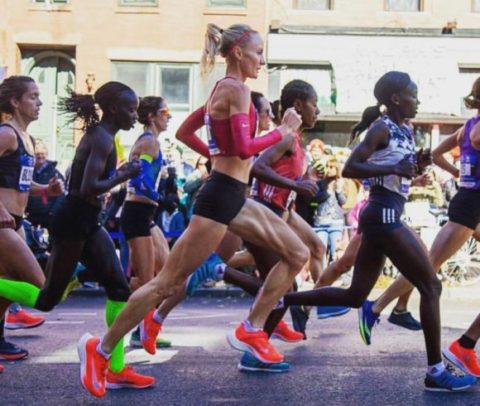
In many sports, speed is an important attribute and ways to improve speed are constantly sought after. To improve speed, you need to increase stride length and/or stride frequency (cadence). Many athletes and coaches initially concentrate on improving stride length only to find that both cadence and speed decrease. It is more effective to work on cadence because this increases the power in the leg muscles which in turn increase stride length.
Running economy can also be improved by developing your VO2 max and vVO2 max, and breathing rhythm.
Stride Length and Rate
The cadence and stride lengths of Olympic track and field athletes were monitored. It was found that competitors in shorter distances had longer stride lengths; female stride lengths varied from 1.5 meters in the marathon, to 2.0 meters for the 800. Male stride length was 1.9 meters in the 10K race to just over 2.4 meters in the 800. However, the cadence did not vary significantly. Cadence for all events (male and female) fell between 185 and 200 steps per minute.
How to improve cadence
To determine your cadence, count the number of times your right foot lands during one-minute of running. Repeat these one-minute runs at different speeds. If you are like an elite athlete, you will find that your strike rate is 90 or more per minute (180+ steps) and is similar for various speeds. If your cadence is less than 90 then make a conscious effort to increase the rate. To do this, concentrate on quicker, lighter, relaxed steps, but do not change the way your feet strike the ground.
Cross country runners need to maintain their cadence when running up hills by adjusting the stride length. If you let cadence slow down, you will find that fatigue sets in and it is harder to get back to the desired cadence once you are over the crest of the hill.
Breathing
Most elite athletes use a 2-2 breathing rhythm. That is, they breathe in for two steps and they breathe out for two steps. The 2-2 breathing rhythm means you are taking 45 breaths (assume you now have a cadence of 180 steps per minute) which is slow enough to allow for a good depth of breathing. It is recommended to practice all kinds of breathing patterns, just to become familiar with them and to note your body’s reaction. Try the 3-3 breathing rhythm, 4-4 breathing rhythm and try unequal breathing rhythms such as 3-2 and 2-3. If you use the 2-2 breathing rhythm and you experience a side stitch, then switch the breathing rhythm to a 3-3 breathing rhythm until the stitch subsides.
Long-term analysis conducted by exercise physiologists Jack Daniels, PhD found that elite athletes in races up to and including the 10K use the 2-2 breathing rhythm at the start of the race and after completing about two-thirds of the race they switch to a 2-1 breathing rhythm. For races longer than 10k the 2-2 breathing rhythm is used for the whole distance, perhaps shifting to a 2-1 breathing rhythm in the last minute or two for the sprint finish. An important point is that your breathing rhythm will not only tell you how hard you are working but also allow you to control how hard you work.